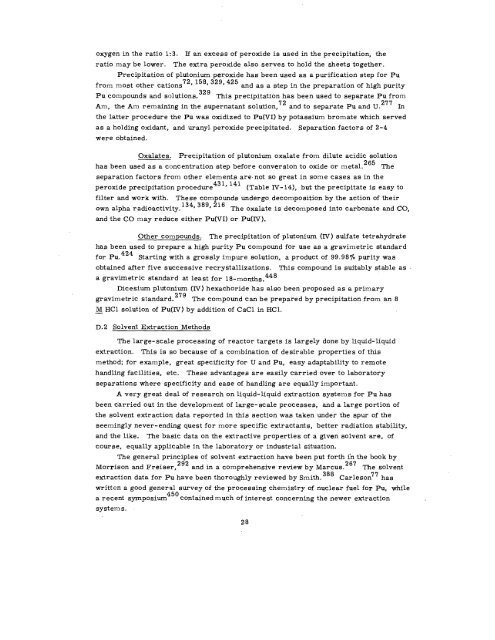THE RADIOCHEMISTRY OF PLUTONIUM - Sciencemadness.org
THE RADIOCHEMISTRY OF PLUTONIUM - Sciencemadness.org
THE RADIOCHEMISTRY OF PLUTONIUM - Sciencemadness.org
You also want an ePaper? Increase the reach of your titles
YUMPU automatically turns print PDFs into web optimized ePapers that Google loves.
oxygen in the ratio 1:3. If an excess of peroxide is used in the precipitation, the<br />
ratio may be lower. The extra peroxide also serves to hold the sheets together.<br />
Precipitation of plutonium peroxide has been used as a purification step for Pu<br />
from most other cations 72, 158, 329, 425 and as a step in the preparation of high purity<br />
Pu compounds and solutions.<br />
329<br />
This precipitation has been used to separate Pu from<br />
Am, the Am remaining in the supernatant solution,<br />
72<br />
and to separate<br />
277<br />
Pu and U.<br />
~<br />
the latter procedure the Pu was oxidized to Pu(VI) by potassium bromate which served<br />
as a holding oxidant, and uranyl peroxide precipitated. Separation factors of 2-4<br />
were obtained.<br />
Oxalates. Precipitation of plutonium oxalate from dilute acidic solution<br />
has been used as a concentration step before conversion to oxide or metal. 265 The<br />
separation factors from other elements are not so great in some cases as in the<br />
peroxide precipitation procedure<br />
431, 141<br />
(Table W- 14), but the precipitate is easy to<br />
filter and work with. The se compounds undergo decomposition by the action of their<br />
134, 389, 216<br />
own alpha radioactivity. The oxalate is decomposed into carbonate and CO,<br />
and the CO may reduce either Pu(VI) or Pu(IY).<br />
Other compounds. The precipitation of plutonium (IV) sulfate tetrahydrate<br />
has been used to prepare a high purity Pu compotmd for use as a gravimetric standard<br />
for Pu.424 Starting with a grossly impure solution, a product of 99. 98~, purity was<br />
obtained after five successive recrystallization. This compound is suitably stable as<br />
a gravimetric standard at least for 18-months, 448<br />
Dicesium plutonium (IV) hexachoride has also been proposed as a primary<br />
gravimetric standard.27g The compound can be prepared by precipitation from an 8<br />
~ HC1 solution of Pu(lY ) by addition of C sC1 in HC1.<br />
D. 2 Solvent Extraction Methods<br />
The large-scale processing of reactor targets is largely done by liquid-liquid<br />
extraction. This is so because of a combination of desirable properties of this<br />
method; for example, great specificity for U and Pu, easy adaptability to remote<br />
handling facilities, etc. These advantages are easily carried over to laboratory<br />
separations where specificity and ease of handling are equally important.<br />
A very great deal of research on liquid-liquid extraction systems for Pu has<br />
been carried out in the development of large-scale processes, and a large portion of<br />
the solvent extraction data reported in this section was taken under the spur of the<br />
seemingly never-ending quest for more specific extractants, better radiation stability,<br />
and the like. The basic data on the extractive properties of a given solvent are, of<br />
course, equally applicable in the laboratory or industrial situation,<br />
The general principles of solvent extraction have been put forth i’n the book by<br />
Morrison and Freiser,<br />
292<br />
and in a comprehensive review by Marcus.<br />
267<br />
The solvent<br />
extraction data for Pu have been thoroughly reviewed by Smith. 388 Carleson77 has<br />
written a good general survey of the processing chemistry of nuclear fuel for Pu, while<br />
450<br />
a recent symposium contained much of interest concerning the newer extraction<br />
systems.<br />
28
















